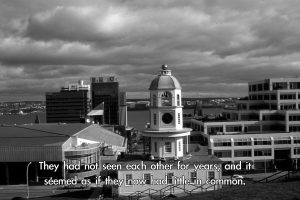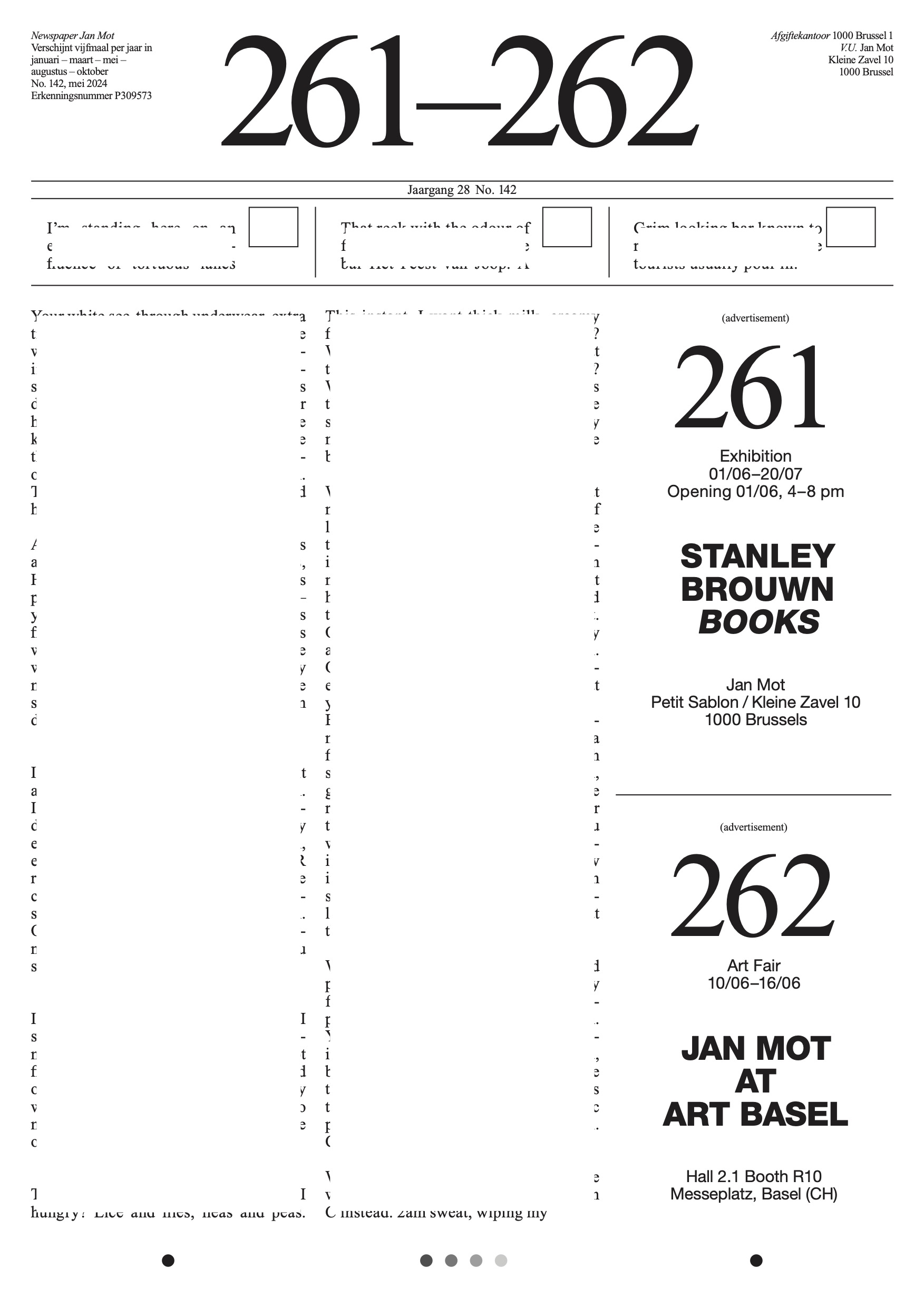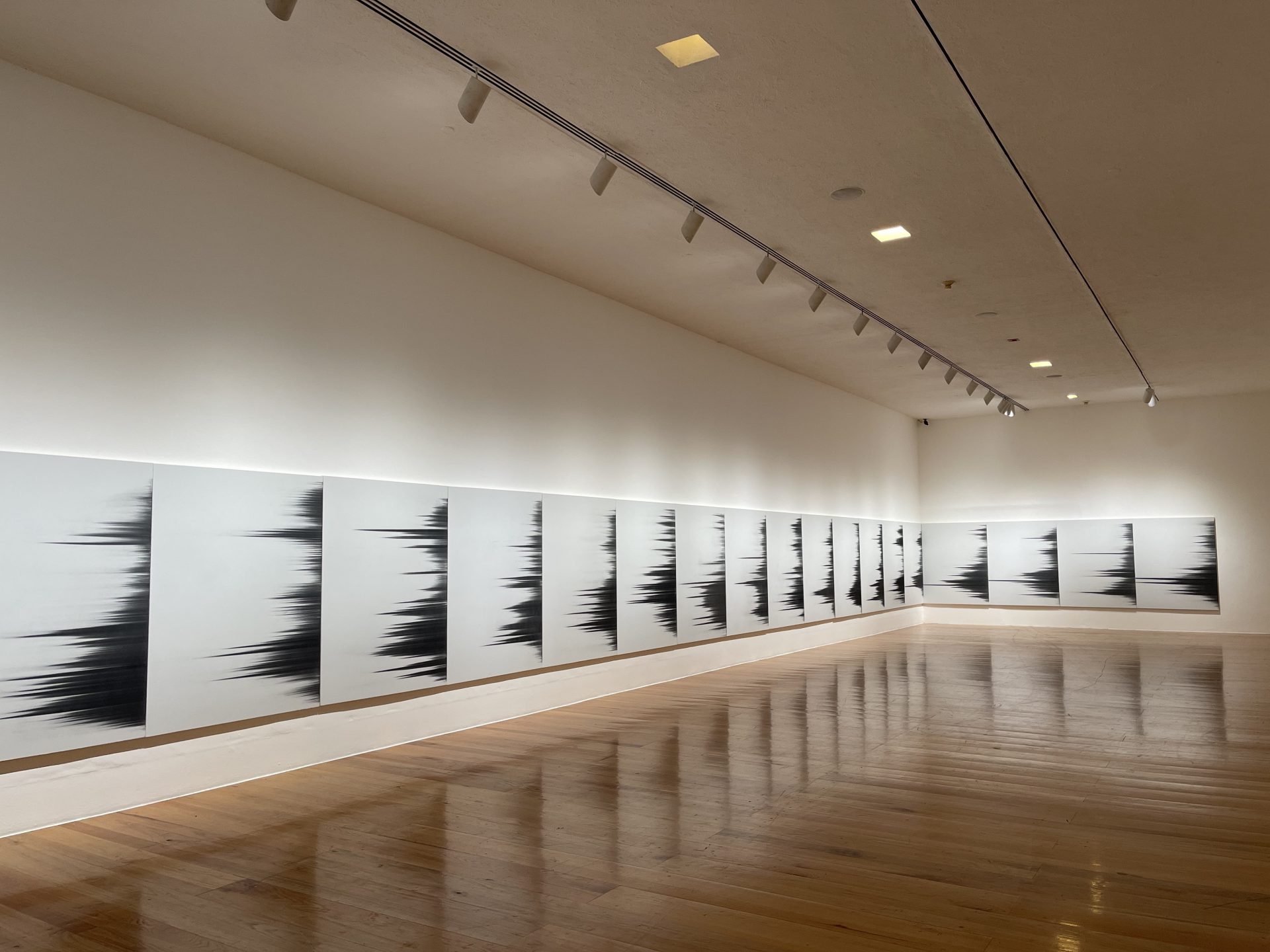Mario Garcia Torres
Exhibitions at Jan Mot

Art Basel, Basel (CH)
Galleries, Hall 2.1 Booth R10
Francis Alÿs, stanley brouwn, Lili Dujourie, Mario Garcia Torres, David Lamelas, Sharon Lockhart, Ian Wilson
Kabinett
Andrea Büttner
Parcours
Dominique Gonzalez-Foerster

Mario Garcia Torres
The Way They Looked at Each Other

Mario Garcia Torres
No doubt, naturally drawn, non-determined nodes, normally detected neutral density. Neal Diamond nose downed near dark. Normal delivery notably drove non-directional navigational displays into North Dakota. And not documented nominal diameter neatly diagrammed non-dated next degree new directions.
Francis Alÿs, Pierre Bismuth, Mario Garcia Torres, Joachim Koester, Tris Vonna-Michell
Mario Garcia Torres, Robert Morris, Philippe Thomas
A situation in which an argument can be discussed

Mario Garcia Torres
September Piece
Mario Garcia Torres, Sharon Lockhart
By June 11 We Will Have Installed Some Works by Mario Garcia Torres and Sharon Lockhart That We Would Like to Share With You and Talk To You About
Pierre Bismuth, Mario Garcia Torres, Annette Kelm, Deimantas Narkevičius

Mario Garcia Torres
All That Color Is Making Me Blind
22/01/09
Mario Garcia Torres
Chinese Whispers
Part of the Oral Culture series
Pierre Bismuth, Mario Garcia Torres, Dominique Gonzalez-Foerster, Will Holder, David Lamelas, Jonathan Monk, Ian Wilson
Time pieces
Mario Garcia Torres
Te invito a mi mundo
Mario Garcia Torres
at Ravenstein Galleries, Brussels
Robert Barry, Manon de Boer, Pierre Bismuth, Daniel Buren, Douglas Gordon Joachim Koester, David Lamelas, Jonathan Monk, Mario Garcia Torres, Ian Wilson
Today is just a copy of yesterday
Mario Garcia Torres
Shot of Grace with Alighiero Boetti Hairstyle and Other Works
Dave Allen, Pierre Bismuth, Dragset & Elmgreen, Hans-Peter Feldmann, Sylvie Fleury, Mario Garcia Torres, Douglas Gordon, Rodney Graham, David Hammons, Isabell Heimerdinger, Jeppe Hein, Carsten Höller, Jonathan Monk
What did you expect?
Other exhibitions

Documenta 13, Kassel (DE) & Kabul
Photo: Roman März
Works
Mario Garcia Torres
If Only I’d Thought Of The Right Words, n.d.
11 randomly played 1-4 min. videos
edition of 5 and 2 A.P.
(excerpt)
For the exhibition An Inquiry: Modes of Encounter, curated by Biljana Ciric , and presented by Times Museum, in Guangzhou, China, Mario García Torres was invited to produce a new piece, developed with Sogou. The Chinese tech company released an Artificial Intelligence based news anchor for the Chinese broadcasting agency Xin Hua. The proposal from García Torres implies a script to be delivered by an AI character in a video. In the words of the artist: “It’s a kind of experiment. I think that my curiosity comes from some kind of impulse; a desire to create a space where, as a spectator you don’t know exactly who is talking to you. I like the tension created by a machine that looks very much like a human. It’s a challenge to see if this robot-cum-person is able to transmit an idea too. It is in this sort of space where you allow yourself to be cheated, because you’re intrigued about this new thing you’ve never seen.”

Mario Garcia Torres, Illusion Brought Me Here, installation view at Wiels, Brussels, 2019, photo: Kristien Daem
The blue paintings represent the announcement of a work: they address the presence of the work in a space that is other than the one in front of the visitor’s eyes. In other words, they are a simulacrum, something that hangs there in front of our eyes, but really refers to some other thing and place – that, probably, is also what real painting, is about.

Mario Garcia Torres
AflmB0ut_A&B_Kbul, n.d.
acrylic paint on canvas
related film: Tea
110 x 195,5 cm
unique

Mario Garcia Torres
NotSaidScrptReadbDL, n.d.
acrylic paint on canvas
related film: Unspoken Dailies
72 x 100 cm
unique
Mario Garcia Torres
Silence’s Wearing Thin Here, n.d.
sound piece (optionally with video)
Commissioned by the Walker Art Center, Minneapolis and WIELS, Contemporary Art
20 minutes
edition of 5 and 2 A.P.
The audio piece Silence’s Wearing Thin Here is composed of sound fragments that Mario Garcia Torres selected from a range of multimedia works he made from the 2000s onwards. The aim was to provide an overarching perspective on the concepts explored throughout his practice. Silence’s Wearing Thin Here offers, as the artist describes it, “an atmospheric road trip” which becomes the context for an abstract discussion between two female, quasi-robotic voices. During their conversation, ideas about time, memory and the politics of images are intermixed with ambient sounds and a multi-part musical score written by the artist and produced with a range of musicians. Garcia Torres conceived this sound piece as the core of “Illusion Brought Me Here,” a solo exhibition presented at Walker Art Center, Minneapolis, 2018 and Wiels, Brussels, 2019. On the occasion of Jan Mot’s Art Basel OVR 2020 presentation he further developed the work by creating a virtual video screening room.

Mario Garcia Torres, Illusion Brought Me Here, n.d., installation view at Walker Art Center, Minneapolis 2018, photo: Bobby Rogers
Mario Garcia Torres
Illusion Brought Me Here, n.d.
augmented reality installation, smart phone app
dimensions variable, certificate of authenticity
edition of 2 and 1 A.P.
Illusion Brought Me Here is an augmented-reality installation. As Mario Garcia Torres describes, it aims to acknowledge the fact that works of art are not the product of one artist’s efforts but rather a combination of personal impulses influenced by the interests and ideas of others. Within the project, he recognises the participation of a number of collaborators - writers, curators, photographers, musicians and gallerists - who have contributed to the development of his work.
Visible through the mobile app, avatars of people influential to Garcia Torres’ career take the form of 3D holographic portraits that appear in the space. These characters perform small actions, referencing a specific place or moment in time, to reflect the artist’s memories.
The work has been exhibited at the Walker Art Center in Minneapolis and Wiels in Brussels in the artist's solo show entitled Illusion Brought Me Here (2018/2019), at Jan Mot's booth in Art Basel in 2019 and subsequently at the gallery.

Mario Garcia Torres
Falling Together in Time, n.d.
video, color, sound
15 minutes 7 seconds
edition of 5 and 2 A.P.
(film still)
Los Angeles, 1981 — before Muhammad Ali fought his last ever fight, the then 39 year old talked a man down from leaping off a high building in order to change the course of his own life. The same year, in the same city, Eddie Van Halen composes the synthesized music for Van Halen’s greatest hit “Jump;” not yet knowing how hard it would be to convince the rest of his band to use it.
This is the beginning of a series of events that, in García Torres’ narrative, all overlap and create a string of intriguing coincidences. Mixing philosophy and popular culture the artist creates a video thesis about time and the endless possibilities to see life. In a text were it becomes confusing if time changes life, or coincidences change thought in the moments when subjectivity considers altering its daily life.

Mario Garcia Torres. No doubt, naturally drawn, non-determined nodes, normally detected neutral density. Neal Diamond nose downed near dark. Normal delivery notably drove non-directional navigational displays into North Dakota. And not documented nominal diameter neatly diagrammed non-dated next degree new directions, installation view at Jan Mot, Brussels 2016
Mario Garcia Torres’s series of works n.d. (no date) resonates his practice of omitting dating his work. By not dating his work and using n.d. at the place traditionally attributed to signature, Garcia Torres challenges the basic parameters of art history applied to classify artistic production, at the same time encouraging non-chronological connections within his own oeuvre.

Mario Garcia Torres
N.D., n.d.
graphite on plastilita on canvas
numbered on the back 000014 (rubber stamp)
25 x 20 cm
unique

Mario Garcia Torres
n.d., n.d.
graphite on paper
numbered on the back 000008 (rubber stamp)
20 x 16,1 cm
unique

Mario Garcia Torres
N.D., n.d.
graphite on plastilita on canvas
numbered on the back 000016 (rubber stamp)
25 x 20 cm
unique

Mario Garcia Torres
n.d., n.d.
graphite on paper
numbered on the back 000011 (rubber stamp)
20 x 16,1 cm
unique

Mario Garcia Torres
La importancia de la cotidianeidad (Una narrativa fragmentada sobre la breve historia del Museo Dinámico)
(The Importance of Everyday Life (A Fragmented Tale About the Brief History of the Museo Dinamico in Mexico)), n.d.
installation consisting of 1 sculpture (acrylic on cardboard), 1 painting (gel ink and acrylic on canvas) 2 sheets of typewritten paper (red ink on paper), 1 sheet of overexposed photographic paper
3 unique versions
During the day of September 6, 1962, a group of young, avant-garde, then anti-establishment artists occupied the rooms, hallways, and gardens of an odd-looking house of unconventional proportions and geometries designed by Manuel Larrosa. They hung abstract paintings on the walls, placed sculptures in unexpected nooks and crevices, and used staircases and windows as backdrops for stagings and dance performances. That night, the house at Tepexpan 14, in Mexico City’s sleepy cobblestoned neighborhood of Coyoacán, was transformed into the first Museo Dinámico, conceived by Larrosa and former cultural official Miguel Salas Portugal.
Through the documents, notes, sculptures, drawings, and commissioned soundtrack that compose "Nadie recuerda nada (Nobody Remembers Anything)" (n.d.), Mario García Torres attempts to narrate and reflect on the difficulties—hence the title—of putting together the story of this important but under-researched episode of Mexico´s art narrative, while foregrounding some of its unique qualities—including the attitudes and ideas behind artworks presented.
Mario Garcia Torres
Tea, 1391 (Iranian calendar)
35mm film transferred to color HD video, sound
64 minutes
edition of 5 and 2 A.P.
(excerpt)
The film follows the artist’s journey to Kabul, undertaken more than ten years after his fictionlized search for Alighiero Boetti’s One Hotel in 2001. The artist’s process of physically going to Kabul, thus making a piece of fiction into a reality, raises a number of speculative questions about truth, nostalgia, hospitality, and displacement: What does it mean to return to a place while visiting it for the first time? What would happen if someone looked for Afghanistan, in Mexico? Can one relive a memory even if it may never have really happened? How can a guest become a host due to his belated arrival? The film elaborates on these questions and unravels recollections of Garcia Torres’s and Boetti’s repsectives stories of relocation. Boetti’s move to Afghanistan in 1971 was particularly puzzling and intriguing because of the way the artist disappeared and subsequently reinvented himself through travel and transfiguration, allowing him to leave behind his persona as an artist and become someone else: not only a hotelier, but also one half of a set of fictional twins.

Mario Garcia Torres
Today… (News from Kabul), 2006
graphite on wall, instruction piece
dimensions variable
edition of 5 and 2 A.P.
Mario Garcia Torres
What Happens in Halifax Stays in Halifax (In 36 Slides), 2004 - 2006
50 black and white 35mm slides (transferred to HD video)
9 minutes
edition of 5 and 2 A.P.
Mario Garcia Torres's research on the expiration of works of art led him to study a specific story at the Nova Scotia College of Art and Design in Halifax, Canada. The school, a leading center for conceptual art in the late 1960s and early 1970s, achieved near-mythic status. There, in 1969, artist and teacher David Askevold developed a course called Project Class, in which he invited established artists to propose instructional projects that had to be realized collectively while adhering to an established set of parameters. As part of this program, Robert Barry telefaxed a set of instructions with a simple premise for the artwork-assignment: the students must agree on an idea and keep it a secret. As Barry wrote: "The piece will remain in existence as long as the idea remains in the confines of the group." If the secret were revealed to anyone - Askevold, Barry, etc.- the work would cease to exist. After extensive research, Garcia Torres found several former students who had been involved in generating and keeping the secret and invited them for a weekend reunion in Halifax forty years later. This installation narrates the artist's visit, documents the process of inquiry, and questions the ways in which (art) history eclipses the messy, complicated, and untimely structures of events. The belated encounter with former students is not so much a repetition of the original and obscure "work of art" as the production of new accounts for how to move differently between past and present, content and memory, friendship and loyalty.
Biography
Mario Garcia Torres
Born in 1975 in Mexico
Lives in Mexico City
Bibliography
News


































